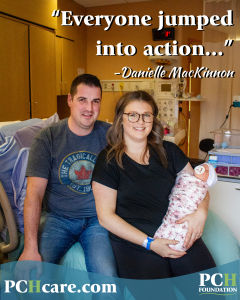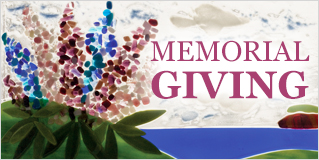 Courage, quick thinking, thorough training, and the unyielding dedication of our healthcare professionals prevented tragedy when every moment counted.
Courage, quick thinking, thorough training, and the unyielding dedication of our healthcare professionals prevented tragedy when every moment counted.
Danielle MacKinnon, a labouring mother, arrived at Prince County Hospital (PCH) on New Year’s Eve with her husband, Alex. She was progressing as expected until a routine assessment uncovered a grave concern – the baby’s heart rate was plummeting with each contraction. “My pregnancy with Lainey was healthy and uncomplicated until her birth,” said Danielle in a January interview with the Foundation. “There was never really a time when I felt that something was wrong until it was time for Lainey to be born. Early labour started in the afternoon on New Year’s Eve and we made the drive to PCH for an assessment. Initially, we thought that Lainey would be born before midnight, but she decided she wanted to wait until New Year’s Day! I was just about fully dilated and ready to push when Dr. Barbrick-Crozier was examining me. She told me we had a prolapsed umbilical cord and not to push”
A prolapsed umbilical cord is a major labour emergency. With each contraction, the baby’s lifeline was compromised, a dire situation. Explains Sandra Graham, RN Clinical Educator on Maternal Child Care Unit (MCCU), “The umbilical cord that goes from the baby to the mother gets trapped between the baby and the outside world. It’s coming first, so with every contraction, the blood and oxygen supply to the baby is stopped. It’s rare. To be frank, there’s a high likelihood of death of the baby when this happens. It is about as serious as it gets for an emergency.” Danielle knew exactly what this meant. She worked in the Maternal Child Care Unit from 2016 to 2022 when she went on her first maternity leave after giving birth to her son, Noah. “And the fact that she was a labour and delivery nurse, she knew that this was so high risk,” Sandra explained.
Said Danielle, “Everyone jumped into action right away, there was no delay at all. I knew what had to happen and I knew I needed to stay calm. Next, I knew I had to keep my family calm. I explained to my husband what was going on and that I needed to go to the OR for a Cesarean birth and that he wouldn’t be able to come with me. The contractions were about 1.5 to 2 minutes apart so breathing and focusing on not pushing was my biggest focus.”
Sandra continued, “What happens at that moment happens quickly. The staff have trained for this.” The labour and delivery team, armed with training and a sense of purpose, leaped into action. The team on hand included a paediatrician, an obstetrician, a respiratory therapist, an anaesthetist, two labour and delivery nurses, two OR nurses, and a surgical assistant. The team rushed to the Operating Room while a labour nurse held the baby internally to relieve pressure on the cord. Danielle remarked to the nurse, “Is this your first cord prolapse?” And when she replied it was, Danielle responded, “Mine too.”
Sandra Graham emphasized the crucial role of simulation training in preparing the healthcare team for emergencies. She delved into the meticulous preparation undertaken by the hospital, describing how they had simulated scenarios involving the entire team only weeks before the actual event unfolded. The people at Danielle’s side had practiced scenarios mirroring her situation, honing their skills and building a reflexive response to emergencies. Little did they know that the simulated scenarios would soon manifest into a real-life challenge for the whole team who must move in a practiced, unified way. Sandra specifically underscored the indispensable role of respiratory therapists (RT) in critical situations. “Having the ability to consistently provide safe, effective and efficient care in an emergency situation like this is a critical component in care of birthing persons and their newborns.” She passionately advocates for the presence of RTs during higher-risk childbirth situations, stressing that their specialized skills, especially in managing airways, were pivotal in ensuring the best possible outcomes for Danielle and Lainey.
Danielle explained how the rest of her story unfolded, “Because of the nature of a prolapsed cord and the logistics behind keeping Lainey safe, I was taken to the operating room on the labour bed with my labour nurse, Rachael, riding along. Once we got there, I remember a lot of commotion, but everyone was keeping me informed every step of the way. Nurses Amanda and Jenn were keeping me calm, talking me through it all. Quickly, the OR team started to arrive. By this point, my belly was prepped, and the table was draped. Dr. Dan Albrechtsons, the MCCU nurses, and RT Abdul Rahman were there for Lainey and I knew she would be okay. The anaesthetist arrived and within minutes I was put to sleep. I remember waking up in the recovery room to the sound of Kelsey’s voice – a former MCCU co-worker and friend. The next voice I heard was Dr. Dan telling me Lainey was safe and healthy and perfect. I don’t remember much after I found out Lainey was safe – I think it was my body’s way of saying ‘Okay, you did it – you can relax now’.”
Danielle’s story ends with a healthy baby girl and thankful parents. “She is perfect and beautiful, and we are so in love,” Danielle professed. This outcome was possible because PCH had the right healthcare providers when time was of the essence and they had trained for this moment using essential equipment. Thanks to the PCH Foundation’s generous donors, this hospital has been able to invest in simulation technology which proved to be indispensable to Danielle and her family. Our donors have emerged as heroes in this tale alongside our PCH team.






